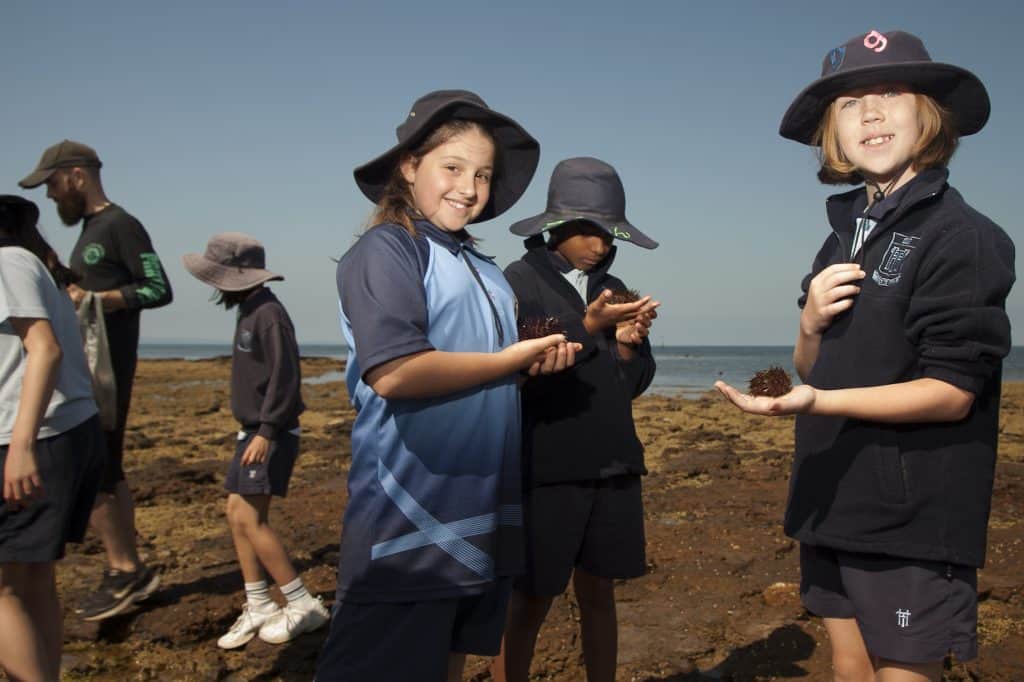Everything Beachy
-
Biodiversity
-
Human Impacts
-
Classifications
-
Feeding Relationships
-
Living Organisms

Program Overview
Ricketts Point Marine Sanctuary provides an opportunity for students to identify the living and non-living components of habitats and discover how organisms rely on each other and their physical surroundings to survive. By exploring the foreshore and intertidal zone, students experience how scientists use common features to classify living things into scientific groups.
Educators introduce the concept of food webs through a group activity and highlight how human activities can affect feeding relationships. Students will devise positive actions that contribute to more sustainable patterns of living and help to protect our fragile marine ecosystems.
We offer this as a 2 or 4 hour program and can be tailored to suit different levels of understanding, from topic introduction through to topic consolidation.
Program Outline and Activities
There are two options for this program – a two-hour program which typically includes the first three activities listed below (unless you request an alternative), and a four-hour program which includes all five activities:
Creature Features
Students examine a variety of marine artefacts and specimens to discover the distinguishing features of organisms from common classification groups.
Intertidal Investigation
By identifying the living and non-living components of the intertidal zone, students will develop an understanding of how species rely on each other and their physical environment in order to survive.
Coastal Classification
Students are introduced to the concept of scientific classification through a simple sorting activity and group discussion. Working in teams, students explore the sandy foreshore to collect examples of non-living, once living and products of living things. Classification skills will be further developed through the identification of the common characteristics within specific animal groups.
Marine Debris
Participate in our interactive story to discover how human activities can impact our precious aquatic environments. Through group discussion, students will devise solutions and positive actions to contribute to more sustainable patterns of living.
Fragile Food Webs
Through group collaboration, students will create a food web representing the feeding relationships of the intertidal zone. The roles that species play within the food web and the impacts of human activities on these fragile systems will be identified.
Both programs conclude with:
Call to Action
By defining their connection to the coastal environment, students will develop everyday actions they can take to reduce their impact on the marine environment.
Certificate and Conservation Code to reinforce learnings
Post event, schools will be issued a Certificate of Participation and Conservation Code for each class which students are encouraged to sign and hang in the classroom as a reminder of their learnings and their commitment to protect the environment.
We encourage schools to connect with us a few weeks or months after school excursions to share behavioural changes made by the students or activities they have undertaken as a result of their learnings during “Everything Beachy” so we may share success stories to inspire others, monitor the ongoing impact of our programs and make relevant updates or changes if required.
Restrictions: The program is dependent on tides, therefore available dates are limited. More than four classes can be accommodated by special request, however is only available for our four-hour program.
Equipment needed: Appropriate clothing and footwear (long sleeve top, long pants, jacket, hat/beanie, soft-soled shoes e.g. runners). Students participating in the two-hour program will need to bring a snack and water. Classes undertaking the four-hour program will also need to bring lunch.
Victorian Curriculum Links
SCIENCE: Science Understanding
– Science knowledge helps people to understand the effects of their actions (VCSSU056)
– Living things can be grouped on the basis of observable features and can be distinguished from non-living things (VCSSU057)
– Different living things have different life cycles and depend on each other and the environment to survive (VCSSU058)
SCIENCE: Science Inquiry Skills
– Represent and communicate observations, ideas and findings to show patterns and relationships using formal and informal scientific language (VCSIS072)
GEOGRAPHY: Geographical Knowledge
– Types of natural vegetation and the significance of vegetation to the environment, the importance of environments to animals and people, and different views on how they can be protected; the use and management of natural resources and waste, and different views on how to do this sustainably (VCGGK082)
– Similarities and differences in individuals’ and groups’ feelings and perceptions about places, and how they influence views about the protection of these places (VCGGK083)
The Victorian Curriculum F-10 content elements are © VCAA, reproduced by permission. Victorian Curriculum F-10 elements accurate at time of publication. The VCAA does not endorse or make any warranties regarding this resource. The Victorian Curriculum F-10 and related content can be accessed directly at the VCAA website.
